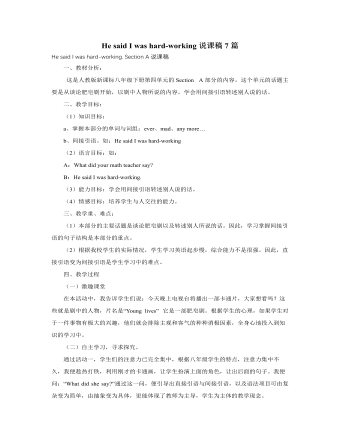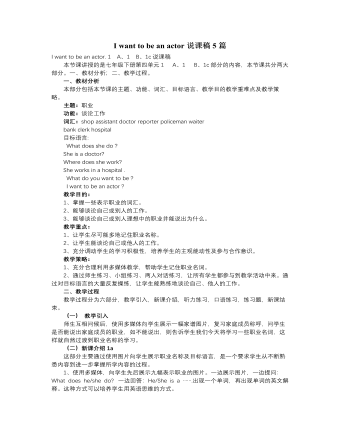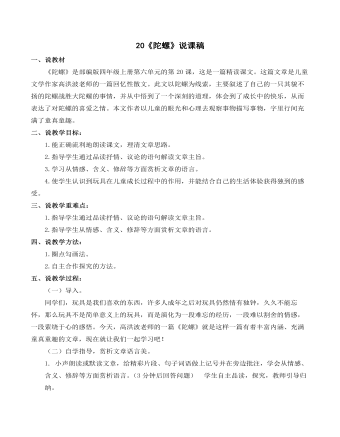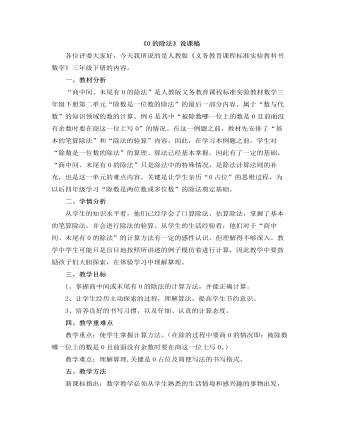人教版新目标初中英语八年级下册What should I do说课稿8篇
-
- 页数:31页
- 字数:约 33646 字
- 大小:252.50KB
- 格式:.doc
- 版本:Office2016及以上版本
- 作者:大猫丶演示
What should I do说课稿8篇
What should I do? Period1说课稿
一、教材分析及学情分析:
运用直观教学法,实施任务型教学,给英语教育教学注入了新的活力和动力。依据任务型教学理念,我们先找出本单元中每个课时的中心话题或任务是什么,然后围绕这个中心话题或任务展开任务型教学。本单元中第一课时的中心话题是: What’s wrong?

Maybe you should ------.
本节课围绕“存在问题、提出建议”展开讨论。运用教学图片和卡片,实施任务型教学,使英语课堂充满趣味性,同时培养了学生用英语思维的能力。
二、教学目标:
1、学习有关“存在问题、提出建议”的短语和句子。
2、话题: A: What’s wrong?
B: I ------ .
A: Maybe you should ------ .
3、训练学生的听说演等能力。
4、培养学生的合作学习精神。
三、教学重点:
What’s wrong? Maybe you should ------ .
四、教学难点:
should+动词原形
五、教具:
图片(4张)、卡片( 7张)、录音机一台。
六、教学步骤:
Step1 Sentences and phrases learning
1. Show four pictures and a card .
(My clothes are out of style; My brother plays his CDs too loud; Myparents wants me to stay at home every night; I argued with my best friend; Idon’t have enough money.)
Read after the teacher these problems ,then read together.
Let the students speak out the sentences one by one according to thepictures or the card.
2. Show some other cards in Chinese, learn these phrases: (buy some newclothes, write him a letter, call him up , you’re sorry, go to his house, givehim a ticket to a ball game.)
Read after the teacher, then read together.
Speak out the phrases one by one according to the cards.
(出示图片或卡片,便于学生对句子或短语的识记和理解;且能有效检验学生掌握知识的情况。这些为任务型教学的实施作好了准备。)
工 Step 2Presentation
Write the dialogue on the blackboard:
A: What’s wrong?/ What’s the matter?/ What’s the problem?
B: ------ .
A: Maybe you should ------ .
Point out: should+ 动词原形
(板书讨论主题,为开展学生活动做准备)
Step 3 Discussion
Let the students discuss the dialogue above in pairs for a few minutes.
They can open the textbook of page 10-11,1a and 2a.
Step 4 Performance
Ask some pairs to perform in front. They can use the pictures or cards tohelp them if necessary.
( 以活动为中心的任务型教学,培养了学生的合作学习精神和一定的竞争意识;让学生体验到乐趣贯穿于学习之中,体现了以学生为主体的新课程观。)
Step 5 Check
Let the students make sentences one by one according to the cards orpictures. Just like these:
S1: ------.
S2: Maybe you should ------ .
(一人接一人根据图片或卡片进行对话,全面检验了学习效果。)
Step6 Reading
S B. P10. 1a and 1c. Read the sentences together.
Finish the exercise of 1a.
Check the answers.
Step7 Listening
S B. P10. 1b. Give instructions about the listening exercise.
Listen to the tape about three times.
Check the answers.
Step 8 Homework
Memorize the new words and practise the dialogues after class.
七、教学反思
在教学过程中全面培养了学生的英语听、说、运用等能力。直观式教学与任务型教学始终融为一体。通过开展活动,充分调动了学生学习英语的积极性、主动性和创造性。
What should I do? Section A说课稿
我说课的内容是义务教育课程标准实验教科书《新目标英语》八年级下册第二单元Section A,课题是“What should I do?”
本节说课内容分四个步骤:一、说教材二、说教法三、说学生四、说教学过程。
一、说教材
(一)教材分析
教材的地位和作用:
第二单元承接八年级上册What’s the matter?中有关情态动词should 的用法,并作进一步的扩展和综合运用;本课是本单元的第一课时,集中呈现了本单元的基本词汇和语言结构,因此,本课教学有着承上启下的重要作用。
(二)教学目标
1知识目标:
学会使用情态动词should、could,学习并使用新单词
2能力目标:
(1)能够谈论自己的麻烦和问题。
(2)能够为他人的问题找到合理的解决办法,提出相应的建议。
(3)能够从他人的建议中为自己的问题找到解决办法。
3情感目标:
通过共同探讨、解决各种烦恼和困惑,学会反思自己,体谅他人,树立合作精神,培养积极乐观的情感态度。
我确立教学目标的依据是:
根据新课程标准的规定,通过听说读写的训练,使学生获得英语基础知识和初步运用英语进行交际的能力,激发和培养学生学习英语的兴趣,发展自主学习能力,形成良好品质,树立健康人生观。
(三)教学重难点
根据教学目标和学生特点,我确立本课的教学重点为:学会使用情态动词should、could。难点:能够运用所学谈论问题和困难,选择或提出建议。
(四)对教材的处理
在教材的处理和把握上,始终贯穿“谈论问题、提供建议”这一主线,本着激发兴趣、体验参与、自主学习、学以致用的原则,循序渐进的深化教学内容。
二、说教法与手段
根据本课实用性强、涉及面广、语言运用量大的特点,我确立了如下教学方法和手段:
1.任务教学法,给学生设置不同的任务驱动,赋予知识和技能训练,以他们自己真实的情景和语境,调动学生的参与热情,认真学。
2.听说读写综合训练,培养语言运用能力。
3.知识导入和任务设计由浅入深、由易到难、循序渐进、逐层拓展。
4.采用多媒体教学手段,增强直观性和趣味性,加大课堂容量。
三、说学生
1.八年级学生兴趣广泛,思维敏捷,爱表现,符合本课教学特点。
2.教是为了不教,“授人以鱼,不如授人以渔”,在学法指导上,我注重以下几点:
(1)鼓励大胆开口,积极参与,克服羞涩、紧张、害怕、逃避等消极心理影响。
(2)发展学习策略。
(3)倡导为用而学,学了就用,发挥主动性和创造性,把握课堂实践空间,并努力将这种实践延续到课后。
四、说教学过程
课前歌曲播放 growing pains 为这节课做铺垫。
按照以下步骤完成:1常规报告 2激发情趣,导入新课,3自主探究,理解新知4 Pairwork操练对话,5听力训练,验收成果,6联系实际,巩固运用7布置作业
合理的教学过程是教学成功的关键,为了能让学生轻松的进入课堂,在愉悦的气氛中学习知识,在真实的情景中使用知识,在饶富趣味的话题探讨中,积极沟通和交流,最终达成共识,我这样设计每一个教学环节:
1. 常规报告
这一环节大约需要4分钟。
设计这一环节的目的,是为了激发学生的学习兴趣,培养学生的写作及口语能力,以及应变能力。这也是我平时上课一直在做的。一般TOPIC的设置是随学习进度而来的,因为今天的课是第二单元的第一课时,所以做的DUTY REPORT 是第一单元的主题,这也起到了复习的作用。
2.激发情趣,导入新课
师做咳嗽状,引导学生说出老师的问题,并让他们给出建议。
3. 自主探究,理解新知
让学生自己自由的说出他们的烦恼,同时给出建议。这一段完全由学生自己说,自己生成,我做补充,适当解释重难点词汇。在这个环节中,导入What’s the matter?What’s wrong? What should I /He/She/they do? I /He/She/they should...
在这个过程中将学生们的问题和建议写在黑板上。
在活动过程中,表现优秀的学生,我会马上表扬:Very good , you’rewonderful. 回答不太好的学生我会及时鼓励:Don’t worry, Ithink you can do the best next time, yes?
接下来,老师告诉学生,情态动词could也可用来提出建议,当你对自己提出的建议不是十分有把握的时候,那就要用到could,而不是should了。
通过这样的设计,使知识由浅入深,由易到难,层层展开,既学习了新单词,又复习巩固了情态动词should肯定和否定的用法,并学习了可用来提出建议的又一个单词“could”。另外,在解释argue with 这个词组的时候,也对学生进行了思想教育,使他们学会反思自己,体谅父母。
在交流的过程中,老师进一步引导学生们对每条建议加以评价。如:That’s a goodidea! I don’t think so, because … 在这种开放、和谐、互动的语言氛围中,充分调动了学生的参与热情,感受语言魅力,体验知识的实用性,培养了学生的合作精神和自省能力。
4.Pairwork 操练对话
以两人为一组,进行对话,给出情景,操练输出。
5.听力训练,验收成果
要求听录音,完成1b
设计这一环节的目的是:以听的方式集中呈现本课的重点词汇和语言结构,考查学生对本课内容的掌握程度,训练听的能力
6. 联系实际,巩固运用
我是这样设计的:
以小组为单位,展开“记者行动”,调查组内成员在学习和生活中所遇到的种种麻烦和问题,认真做好记录,并给出相应建议。然后填写调查表,准备在班上做记者报告。每人写在课堂笔记本上,每组派一个代表进行汇报。
设计这一环节的目的是:学以致用,体现英语学习的最终目的“为用而学,用中学,学了就用”,把握课堂实践空间,巩固所学,并将这种实践延续到课后。扮演小记者,满足了学生的表现欲,激发和培养了学生学习英语的兴趣。
7.布置作业
利用课余时间开展调查,了解社会中存在的一些问题,然后尝试写一篇短文,针对这些问题,提出可行方法和建议。
布置作业大约需要两分钟。
由于缺少经验,在教学过程中难免会出现不足,敬请各位领导、老师不吝赐教。谢谢大家!
What should I do? Section A说课稿二
Good morning, everyone!
I’m(). I come from ()Middle School.今天我说课的内容是人教版《新目标英语》八年级《Unit2 What should I do ? Section A》。下面我将从教材分析、教法运用﹑学法指导、教学过程、板书设计﹑教学反思这六个方面对本节课的做具体阐述。
一、教材分析
《新目标英语》教材的语言教育理念是:知识用于行动,强调语言应用,培养创新、实践能力,发展学习策略。它采用任务型语言教学模式,让学生在完成任务的过程中,使用英语获取信息,用英语进行交流,培养运用英语解决实际问题的能力。
本单元的中心话题是谈论各种问题和给出建议。掌握特定的语言结构,听取有用信息。讲究合作,注重逻辑比较,社会意识和人际交往。本节课是一节听说课,作为第二单元的的第一课时,重点是向学生展示新的语言目标,着重训练听说。
﹙一﹚教学目标
根据新课程标准的理念,学生的学习目标应将知识与能力、过程与方法、情感态度与价值观这三方面融为一体。因此,我将本节课的教学目标制定如下:
1. 语言目标:
词汇:play, argue, wrong, style, out of style, could, call sb. up,ticket, surprise, keep out, on the phone. What’s wrong? What’s the matter?。
句型:What’s wrong? / What’s the matter?
What should I do?
You could / should …
2. 能力目标
A: 让学生学会在现实生活中既会用英语去谈论自己在身体、学习、生活上遇到的不同问题,又会给别人提建议,还要会合理评价。培养学生自我解决问题的能力。
B:提高听说水平。
3. 情感目标
当今的孩子大多是独生子女,从小在大人的呵护下长大,没遇到多少挫折和困难,因此造成一旦遇到什么问题就很慌乱无主的状况,容易一蹶不振。通过本节课的学习,希望能提高学生的实际交际能力,学会一些解决问题的方法,与他人和睦共处,互相关心,在爱与被爱中成熟心智。
﹙二﹚教学重点
A: 词汇及重点句型。
B: could 和should 的用法。
C:听力。
(三)教学难点
根据新目标英语的的要求和学生的实际情况,我把本节课的难点确定为以下两点:
1. 在现实情景里,灵活运用句型,真正敢开口用英语交际,去提出和解决实际问题。
2. 听力的提高。
二、教法运用
八年级的学生有了一定的英语基础和自主合作的能力,易于接受新事物。但他们对简单的听说读写训练和教条化的东西已不能引起他们的兴趣。因此,本节课我将从引导学生的兴趣入手,采用5P教学法,通过图片展示、听力训练、情景设计、对话练习、游戏竞赛等一系列活动,让学生在一种快乐轻松地氛围中学会英语交际,提高英语素养。
三、学法指导
本节课将采用听说法﹑讨论法﹑比较归纳法、自主探究法和各种合作式学习法。让学生围绕着课堂任务分工合作,在活动中相互探讨,相互交流,相互合作,从而获得知识技能和体验,发展他们的能力。
四、教学过程
Step 1 :Preparation 准备
1. 上课前几分钟,播放一首学生熟悉的英语歌,学生可跟唱。这样做的目的是帮助学生尽快进入到英语氛围中来,并缓解他们的紧张情绪,为接下来的课做好铺垫。
2. Free talk. 可谈论日期、身体、天气等。这样是为了给学生多创设一些英语交际情境,复习以前学过的内容。
3. 播放一曲很大声很强劲的音乐,然后问大家:How are you feelingnow? Are you feeling comfortable now? 学生会答:No.接着提示:你们遇到这种情况,会怎么处理呢?鼓励学生说出自己的看法,这样自然导入新课。
Step 2 :Presentation 新授
1. 老师套上一件非常不合身的过时了的衣服,然后问:Am I smart?
学生会说No. 老师接着以一种非常难过的口气说:Oh, I’m very sad. But you are right, this coat is out of style, it’s not in style.So it makes me not smart. Can you tell me what I should do? 新授style, instyle, out of style. 然后学生开始提建议。
和学生一起讨论总结出could 和should 的差别。
2.出示四幅图片。第一幅图片:Lily , Mary 两人在争吵。出示 argue with sb.(与……争吵)。问学生:What’s wrong with them? 要求学生用一句话来描述图片内容。E.g. Lily is arguing with Mary.
板书目标语言: What’s wrong (with sb.)? / What’s the matter?
出示另外三幅图片及提示词。第二幅:keep out不让进教室。第三幅:邻居播放的音乐声很大。第四幅:晚上只能呆在家里。按第一幅图的方法去教。
通过直观的图片,让学生学会观察,提高他们的口语表达能力,在学习了新词汇的同时,也为今后的书面表达打下了坚实的基础。
3. 1a. 指导学生读懂不同的问题,然后讨论这些问题是否严重。叫几名学生跟大家分享他们的意见。这部分可以让学生的口语表达及英译汉的能力得到提高。
4. 听力训练。
1b. 指导学生对照1a的问题听录音,将所听到的问题圈出来。请一名学生说出答案。
2a. Say: Peter argued with his bestfriend. Now, his friend is giving him some advice. Listen and circle could orshould. 用小黑板展示:
2b. Listen again. 将朋友的建议与Peter不喜欢的理由连起来。一起核对答案。新授call sb. Up, ticket, surprise 和 on the phone. 让学生带着具体的目标去听录音,可帮助他们找到特定信息,增强自信心。
Step 3 : Practice 练习
Groupwork:
学生两人一组分角色表演Peter和他朋友的对话,然后请三组上前表演。
Step 4 : Production 产出
竞赛游戏(也称为“夺星大战”)Star wars wins
将学生分成四人一组,给每组发一张不同的图片(上有编号),上面写着不同的问题,如:感冒,咳嗽,上课迟到等,还有相应的提示词。学生合上课本,先讨论并动笔写下他们自编的对话。然后采用抽签的方式(老师抽),抽到的组上前表演他们自己的对话,一共抽5组,表演完后,学生给他们评价,得星最多的组获胜。这部分以竞赛游戏的方式让学生将本节课的目标语言得到很好的操练、巩固和提高。学生团体协作的意识也有所加强。
Step 5 : Progress 发展
给出一个话题: I want to learn English better, what should I do?
学生课后讨论并写下自己的建议。这个环节主要是为了避免学生只在课堂上练英语,又训练了写作,还可以通过查阅资料、讨论的方式去找到更好的学习好英语的方法。
五、板书设计
板书设计应充分体现本节课的重难点,因此,我将本节课的板书设计如下:
六、教学反思
整个教学设计,我想突出“三重”:一重听说训练,通过听力和口语训练培养学生的英语交际能力。二重人文渗透,学生在分工协作中,得到至真至诚的同学情谊。三重快乐学习,通过游戏活动,加深对新知识的了解和记忆,课堂不会死气沉沉,体现了“寓教于乐”的思想。
通过本节课的教学,我感觉学生能围绕任务分工合作,积极主动的学英语。但学生开口交际能力仍然较弱,还要多想办法,我们可以课后组织开展英语角以及其它各项英语竞赛等活动,去挖掘他们的英语潜能。他们毕竟还只是孩子,需要我们做老师的多鼓励,因此我们多用激励性的语言对激发他们的英语学习兴趣应该很有帮助。
What should I do? Section B说课稿
Teaching objects
By the end of the class, students will be able to talk"problems" freely and reasonably.
Languages focus: should \original\style\the same as
Listening skills: students will be able to get the main idea and detailedinformation.
Attitude: to know that problems are common in daily life, everyone shouldtry to face them
and solve them to make life better.
Lead in
Students translate two sayings into Chinese, and then have a discussion.
Clothes make the man.
Clothes dont make the man.
(讨论两句有关衣服的谚语,引入本节讨论的主题problems about appearance,并引发学生思考,自己在穿着、发型等方面是否存在问题。)
Before listening
1.Show two pictures about different clothes, let students describe them.
(主要学习和总结 original\comfortable\the same as\ inexpensive等词汇,并尝试用英语解释部分词汇,以加深理解,original means new, interesting, different from\style
means the way that something is done or built\inexpensive means cheap)
2.Students answer the following questions with the sentences.
What is important for you?
What isnt important for you?
1) They are original.
2) They are comfortable.
3) They are the same as my friends clothes.
4) They are in style.
5) They are inexpensive.
6) They are colorful.
(巩固上面词汇的用法及表达,为学生思考my problems with clothes做准备)
3.Students answer two questions.
1) Do you have problems with clothes? If yes, what’s it?
2) Do you have problems with haircut? If yes, what’s it?
If some students have the problems, teacher can guide others to discusssome advice.
(Prepare for the listening)
While listening
Erin is a girl, she also has a problem, and she is calling “teen talk” forhelp, let’s listen to
the tape and learn more about her.
1. Students read the sentences in the book quickly then have a guess.
What’s her problem about?
(利用已有的材料,推测听力的主题或有可能涉及到的问题。)
2. Students listen to the tape and choose the true answer. After this, workin pairs to
discuss the question.
Do you have the same problem as she does?
Why dose she have the problem?
Can you give her some advice?
(验证猜想,明确答案。通过问题的讨论,尝试培养学生的英语思维能力,同时可呈现新的语言知识,she copies everything as I do ,I want to be original.)
3. Students listen to the tape and fill in the chart.
Person
Advice
Kim
Nicole
Emilio
(听细节,根据自己所学整理出答案)
3. Students listen to the tape completely then complete the conversation.
(克漏填空,整体把握听力内容,突出听力材料中的语言知识。)
After listening
1. Show two problems, le students give me some advice.
1) I am always tired; I think I’m kind of unhealthy, what should I do?
2) One of my students always plays computer games too much , he can’tfinish his
homework on time, what should I do?
(老师出示自己的问题,让学生给出合理的建议,给学生发表建议的机会)
2. Group work
Students work in a pair of four, write down their problems(especiallyabout appearance),then
have some advice with the help of the group.
(小组合作解决自身存在的问题,在经过自己的思考后畅所欲言)
Task share your joys
In our life, we have some problems, but we have more joys, such is truelife. Let’s share
your joys.
(通过该任务让学生明白,生活中的问题固然存在,但更多的是欢乐,如有问题我们要以恰当的方式解决,如有欢乐,要懂得分享。若难以操作,可给出下列问题给予提示)
1. Are you taller than last year?
2. Are you healthier than before?
3. Did you get a beautiful gift?
4. Did you have a good trip?
5. Do you have more friends?
6. Do you have good grades now?
Summary and homework
1. Collect five students’ problems and give them your advice.
2. High—level students write a composition about “my present problems”.
What should I do?说课稿
一、教材分析
二、学情分析
三、说教法
四、说学法
五、学习策略与思维技巧
六、评价手段
七、课时划分
八、教学流程
一、说教材
1、教材的地位及作用:
本单元的核心教学项目是“讨论问题及给出建议”,各部分围绕这核心项目设计安排了听、说、读、写活动。各部分内容均取自于学生的日常生活,实用性强。学生们会因为此话题的趣味性及实用性而感兴趣, 故能在学中用,用中学,印象深刻。
Section A是语言训练课。第一部分(1a—1c)提出了一系列的问题,同时也为学生提供了语言训练的样板。第二部分2a—2c是对存在的问题给出建议。第三部分是所学语言知识的自然延伸,让学生对提出的建议作出自己的判断。
Section B 是A部分内容的拓展及延伸,扩展词汇,强化听力,培养阅读和写作,给出你对问题的建议。
Self-check 进一步练习了本单元的主题内容,让学生能对存在的问题给出合理的建议。
Reading 部分培养学生的阅读能力及分析解决问题的能力。
2、教学目标:
(1)知识目标:
A、掌握本课中出现的四会单词、词组和句型,并在口、笔头中运用。
B、掌握情态动词should与could的用法。
(2)能力目标:谈论在学校和家庭中遇到的麻烦和问题,培养交际能力; 为他人找到合理的解决办法,提出相应的建议。
(3)情感目标:让学生学会自己解决问题并给他人提出建议,增进彼此的友谊。
3、确定以上教学目标的理论依据:⑴课程标准及教学内容的要求。⑵学科渗透、发展能力的原则。⑶寓德育教育于教学活动之中的要求。
4、教材处理:
根据以上对教材的分析,同时针对中国学生学习外语存在一定困难的实际情况。首先给学生树立榜样,激发学生学习兴趣,使学生在创设对话、参与活动的一系列活动中,掌握知识。最后通过做游戏对学生所学知识点进行训练,从而达到巩固知识的目的。
二、学情分析
1、学习现状:已学习了一些较为长篇幅的英语阅读课文,对于英语知识和英语会话及英语活动都有了一定的认识。
2、学习动力:对英语学习仍有浓厚的好奇心,并保持着较高的学习兴趣。
3、学习习惯:学生学习的自觉性和方法欠缺,教师应加强对学生的英语学习兴趣的培养和学习方法的指导。
三、说教法:
教学方法具有多样性、灵活性和发展性,在进行具体的教学过程中,教学方法不是固定不变的,教学理论认为选择和采用正确的教学方法,不仅要根据学科知识特点,而且要根据教学任务,学生年龄特征及学生实际情况来定。为了更好地突出本课重点、突破难点,根据教情和学情,本课主要采用以下教法:
A、直观教学法:
根据本课教学内容,我利用书中的图片、实物、挂图直观教具,让学生理会并掌握本课知识。
B、交际法和情景教学法:
根据课程标准要求及本课教学内容。本人在课堂教学过程中设计一些真实情景,将现实生活场景引入课堂,以便使学生面对生活情景组织语言材料,进行语言材料。
C、以学生为中心和任务型教学
新课程标准的总体目标是“培养学生的综合语言运用能力”。任务型教学旨在培养学生在生活中运用语言的能力,也就是学会用语言做事情。学生在任务型学习中所获得的经验,有得利于把语言较顺利地应用于真实交际。
任务1:让我们相互帮忙
任务2:最佳节目主持人
任务3:我的生活从此没有“不能”
四、说学法:
教与学是相辅相成、互相促进的活动。因此,在课堂教学中,教师应最大限度地调动学生学习的主动性和积极性,激发学生的创新思维,使学生参与到课堂教学之中,变被动学习为主动学习。根据本课内容与课程标准要求及学生的语言学习规律,指导学生课前预习,培养学生自主学习的意识;课堂上通过视听,培养学生快速获取生词、文章大意的技能。
为了充分发挥学生的主观能动性,更好地完成教学任务,在上述教学方法的指导下,引导学生掌握“观察、模仿、合作”的学习方法,通过观察、比较,让学生能自行归纳总结,通过模仿、合作,让学生自行组织运用所学进行交际。
五、学习策略与思维技巧:
听取特定信息和合作。
六、评价手段:
本课的评价手段有二种,即形成性评价和小组评价。
七、课时划分
Period 1: Section A
Period 2: Section B 1a-2c
Period 3: Section B 3a-4
Period 4: Self-check
Period 5: Reading practice
Period 6: Reading practice
八、教学流程
Period 1Section A
In this unit we will talk aboutproblems people have and learn how to give these people advice →1a. introduces some key vocabulary. →1b. practice target language (listen ) →1c. oral practice →2a&2b. Listening practice (read theinstruction→play the recording→check the answers) →2c. oral practice →Grammar focus →3a. reading and writing practice →3b.oral practice →4.pairwork: give advice
Period 2 Section B 1a-2c
1a. introduce some new words → 1b. oral practice →2a. &2b listening and writingpractice (first, read the instructions. Then, point to the three items. Next,play the recording twice. Check the answers.) → 2c. oral practice using the targetlanguage, working with a partner.
Period 3 Section B 3a-4
Have a check about the contents on p13.→ 3a. reading practice (first,read the instructions. Then, read theletter to class. Next, ask students to say what words and phrases they circled.Then, repeat the vocabulary that students circled. Then, ask students tounderline the problem. Finally,check the answer.) →3b. writing practice ( Ask students tosay some advice they might give. Then, ask students to write the letters ontheir own. Next, read their letters to the class.) → 3c. writing practice(ask and offer advice for the others →ask students to complete the work in groups)
Period 4 Self-check
1. Practice the vocabulary and askstudents to make their own sentences with the words, then check the answers.
2. An opportunity for students to engagein open-ended writing. First, read the instructions. Then, ask one or twostudents for advice. Next, ask students to read the letter. Then, complete thework.
3. Just for fun. Reading practice with thetarget language.
Period 5-6 Reading
Section1 Before you read
1a.Studentsthink about life outside school hours. Then, ask students to complete theboxes.
1b.Look up the words in a dictionary.
Explainthat a dictionary can help students learn independently. Discuss the pointsmade in the Reading Strategy about using a dictionary. Let the students do thesame with the other words.
Section2 While you read
Askstudents to read and notice the words they have looked up in theirdictionaries. First, read the article quickly. Then, read the second time.
Section3 After you read
3a.ask students to read the statements , then discuss them with their partners andgive their opinions.
3b.practice new words, ask students to write their own sentences.
3c.Free writing.
Section4 Go for it! Do a survey. 1. When do you feel under pressure?2. What should youdo to relax?
What should I do?说课稿二
一、知识点拨
I.Language Goals
学会谈论有关生活中的问题。
学会针对别人的问题给出建议。
能针对所提出的建议做出评价。
II.Key Words
1.argue v.争论;争吵
argue with sb.与某人吵架
I argued with my best friend.我和我的好朋友吵架了。
2.either adv.(用于否定句)也
He doesnt have any money, and Idont, either.他没有钱,我也没有。
too 也(用于肯定或疑问句)
Im a teacher.He is a teacher,too.我是老师,他也是老师。
3.ask (sb.)for sth.向某人寻求某物;要……
Dont ask for food every day.Go and find somework.别天天要饭,找点儿工作做。
I dont think you should ask yourparents for some money.我想你不应该向父母要钱。
He didnt want to ask his teacherfor his book hack.他不想向老师要回他的书了。
4.the same as... 与……相同
The clothes are the same as myfriends.这些衣服与我朋友的一样。
Tom is the same age as Anna.= Tom is as old as Anna.汤姆和安娜一样大。
5.except 除……以外;(不包括……在内)
My class has been invited except me.= Only I havent been invited.
除我以外,我的同学都被邀请了。
All the students went to the parkexcept him.= Only he didnt get to the park.
besides 除……以外(包括在内)
除他以外,所有的学生都去了公园。
We all went there besides him.= He went there.We went there, too.
除他去以外,我们也都去了。
6.wrong adj.错误的;有毛病的;不合适的
─ Whats wrong with you? 你怎么了?(你哪里不舒服?)
─ Ive got a headache.我头痛。
adv.错误地;不正确地;不对地
He answered wrong.他答错了。
7.get on well with sb.与某人相处融洽
The students will get on well withthe teacher.学生会和老师相处得非常好。
We get on well with each other.我们彼此相处融洽。
8.have a fight with sb.= fight with sb.与某人打架
I dont want to have a fight withmy cousin.我不想和我的堂兄打架。
III. Key Sentences Structures
What should I do?
You could write him a letter.
What should he do?
Maybe he should say sorry to him.
What should they do?
They shouldnt argue.
二、学习自评
I.Listening Comprehension
(A)Listen and matchthe correct pictures.
1.() 2.() 3.() 4.() 5.()
(B)Listen carefullyand write “T” (true)or “F” (false)before each statement.
()1.Jim wants to goshopping for a new shirt.
()2.Jim cant wearsize six shoes.
()3.Jims mother sawsome nice shops the other day.
()4.Jim prefers whiteto blue.
()5.They will buy theshoes on Saturday afternoon.
II.Vocabulary
Match the words with their meanings.
()1.genius
()2.attend
()3.solution
()4.pressure
()5.psychiatrist
()6.upset
()7.family
()8.exhausted
()9.pair
()10.idea
a.strong or oppressive influence
b.not happy
c.people with relatives
d.answer or the way to work out problems
e.too tired to do anything
f.pictures in mind
g.a person who is very intelligent
h.take part in
i.person who studies how people think
j.two things of the same kind
III.Choose the correct answers.
()
1.I dont have any money and he doesnt,.
A.too B.either C.alsoD.neither
()
2.─do you go to the cinema?
─ Every two weeks.
A.How longB.How manyC.How often D.How much
()
3.You can this book for a week.
A.borrowB.lend C.keepD.buy
()
4.Yesterday Dick made me for a long time.
A.to wait B.wait C.waited D.waiting
()
5.I need some money to buy clothes my mother.Her clothes are out of style.
A.after B.to C.ofD.for
()
6.My bike is broken.I have to go to school on foot .
A.alsoB.insteadC.instead of D.too
()
7.My friend has the same haircut I do.
A.asB.likeC.with D.than
()
8.The teacher told him late any more.
A.not to be B.to be notC.be not D.not be
()
9.He the radio and began to listen to it.
A.turned offB.turned downC.turned onD.turned up
()
10.Im very because my best friend didnt invite me to come to his party.
A.popular B.happy C.late D.upset
IV.Form sentences.
1.I, friend, nicer, clothes, my, has, than, do
2.wears, the, clothes, my, same, I, do, brother, as
3.left, your, homework, at, you, home
4.doesnt, he, is, know, ID, where, your, card
5.are, invite, the singer, having, a, my friends, party, and, didnt, they
V.Fill in the blanks with these words.
are, played, for, with, out, about, keep, else, drops
1.My brother his stereo too loud.
2.He is arguing his best friend.
3.Its not easy to get a ticket a basketball game.
4.I dont want to talk Tom in class.
5.He borrowed a new car his father.
6.We found that there would be an important test the next week.
7.Her mother her off on No.302 bus stop everyday.
8.You should everything nice and tidy.
9.Everyone in my class is running except me.
10.The Whites hanging out by the river.
VI.Reading comprehension
(A)
Can you make a telephone call? Of course you can make it in Chinese.But a call inEnglish is quite different from the one ill Chinese.If you want to askMr. Smith to answer the telephone, you cannot say, “Please ask Mr. Smith toanswer the telephone.” Instead you must say, “May 1 speak to Mr. Smith?” If you want to ask ifMr. Smith is answering the telephone, you should say “Who is that? Is that Mr.Smith speaking?” instead of “Who are you?” If you want to tell the other onewho you are, you should say, “This is Tom (speaking).” Instead of “Im Tom.”
()1.An Englishtelephone call is a Chinese one.
A.not the same as B.better than
C.the same as D.as good as
()2.If you want to askwho is answering the call, you should say “?”
A.Who am I B.Who is be
C.Who are youD.Who is that
()3.If you want totell the other one who you are on the telephone,
you should say,“.”
A.This is... B.Im... C.That is... D.He is...
()4.If you want to askMr. Smith to answer the call, you should say“”
A.Please tell Mr. Smith to answer the telephone.
B.May 1 speak to Mr. Smith?
C.I want to speak to Mr. Smith.
D.Are you Mr. Smith?
()5.Which sentence isright according to (根据)this passage?
A.It tells the difference between calls in English and in Chinese.
B.We know how we call in English.
C.We dont understand how we call in English.
D.Its easy to call in English.
(B)
American schools begin in September after a long summer vacation.There are twoterms in a school year.The first term is from September to January, and the second is fromFebruary to June.Most American children begin to go to school when they are five years old.Most students areseventeen or eighteen years old when they finish school.
High school students take only four or five subjects each term.They usually go tothe same classes every day, and they have homework for every class.After class theydo many interesting things.
After high school, many students go to college.They can go to asmall one or a large one.They usually havetopay a lot of money.So many college students work after class to get the money for theirstudies.
Questions
Answers
1.How long is the summer holiday in America?
2.How old do most American children begin to go to school?
3.What do many students do after high school?
4.Why do American college students work after class?
5.How many subjects do high school students take each term?
VII.Writing
Write your advice to solve the following problems.
1.I dont have enough money.
2.I argued with my best friend.
3.I left my homework at home.
4.My classmates didnt invite me to his party.
5.I want to join a club, but my parents dont allow me to do so.
三、相关信息
休息好,才能更好地工作。可是,有时人们不得不在周末加班工作。由于别人都在休息,常常就会遇到许多不便,有时还可能会很危险。
Many people have to work on the weekend.Some people do notmind.Other people think it is terrible.
One man thinks that working on the weekend can be dangerous.He is GrahamCoates.Mr. Coates works in an office in Brighton, England.
On the morning of Saturday, May 24, 1986, he went to the office to do somework.When he got on the elevator, it stopped between floors.Mr. Coates couldnot get out of the elevator.He started toshout, but no one heard him.Then Mr. Coatesremembered that it was a holiday in England.No one was goingto come to work until Monday!
There was nothing for Mr. Coates to do.He had to waituntil one of his workmates came to work and found him.With nothing toeat or drink, Mr. Coates ended up sleeping for most of the time.
Early on Monday morning, the vice president of the company came to workand found the elevator was not working.When the elevatorwas opened, Mr. Coates came out, cold, weak, and tired.He had been in theelevator for 62 hours!
Now Mr. Coates says, “I only use elevators if they have telephones in them.”
What should I do? Section A说课稿
一、课堂实录及点评
Unit1 What should I do? (Section A)
Step1. Pre-task:Free Talk
Topic: What will Haikou be like in 10 years?
T: In Unit 1, we have learned to make perditions. Who can tell us? Whatwill Haikou be like in 10 years?
S1:There will be more trees, more factories, more people and fewer cars, andpeople will be richer and healthier…
T: Whats your opinion ?
S2: I think Haikou will be more beautiful, but there will be more cars,more factories and people ,so there will be more pollution.
T: Do you agree with her ideas?
S3: Yes, I agree. Because people will be richer , they will buy more cars.Many tourists will come to Haikou , the city will be bigger and crowded…Sothere will be more pollution.
T: OK. Some of you think there will be more pollution in Haikou in 10years. Do you like pollution?
Ss: No, we dont.
您可能喜欢的文档
查看更多
人教版新课标PEP小学英语五年级上册What Can You Do说课稿8篇
- 页数:21页
- |大小:58.64KB

人教版新目标初中英语八年级下册What should I do教案2篇
- 页数:16页
- |大小:163.50KB

人教版新目标初中英语七年级下册What do you think of game shows说课稿5篇
- 页数:22页
- |大小:178.50KB

人教版新目标初中英语八年级下册He said I was hard-working说课稿7篇
- 页数:32页
- |大小:186.00KB

人教版新目标初中英语八年级下册What were you doing when the UFO arrived说课稿10篇
- 页数:45页
- |大小:357.00KB

人教版新目标初中英语七年级下册I ’d like some noodles说课稿4篇
- 页数:12页
- |大小:77.00KB

人教版新目标初中英语七年级下册I want to be an actor说课稿5篇
- 页数:10页
- |大小:81.50KB
热门说课稿

幼儿园大班说课稿 动物怎样过冬
- 页数:3页
- |大小:36.00KB
- 说课稿

幼儿园中班课后说课稿 雪花和雨滴
- 页数:3页
- |大小:37.00KB
- 说课稿

《陀螺》说课稿
- 页数:4页
- |大小:39.00KB
- 说课稿

小班生活《小脚找朋友》说课稿
- 页数:2页
- |大小:33.31KB
- 说课稿

小学数学人教版一年级上册《认识钟表》说课稿
- 页数:4页
- |大小:24.27KB
- 说课稿

小学数学人教版三年级下册《0的除法》说课稿
- 页数:6页
- |大小:34.92KB
- 说课稿
今日更新

5月份主题教育工作情况总结汇报
- 页数:3页
- |大小:136.87KB

××县招商局2024年上半年工作总结
- 页数:12页
- |大小:142.54KB

×××公安局机关党委上半年党建工作总结
- 页数:7页
- |大小:186.25KB

《2019—2024年全国党政领导班子建设规划纲要》实施情况的工作总结3800字
- 页数:6页
- |大小:29.16KB

“转观念、勇担当、新征程、创一流”主题教育活动阶段性工作总结
- 页数:3页
- |大小:22.76KB

“四零”承诺服务创建工作总结
- 页数:5页
- |大小:39.83KB





